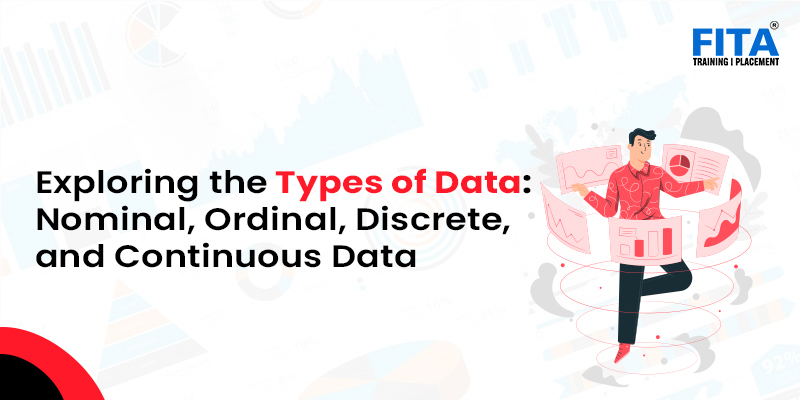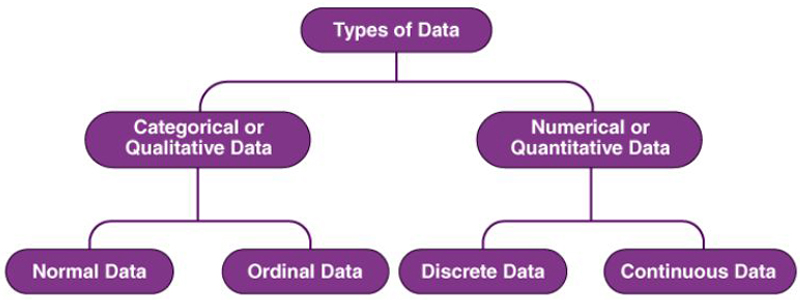
Data is ubiquitous across various domains, making it essential for professionals in different fields such as data science, marketing, business, data analysis, research, and more. Proper handling and storage of data, without errors, becomes crucial due to its significance. To ensure accurate outcomes, it is important to understand the different types of data that exist for processing. If you want to become a Data Scientist, you can join Data Science Training in Chennai, which will help you have a better understanding of Use of Data Science, What is Data Science, How it Works and type of Data.
Classification of Data
- Nominal data
- Ordinal data
- Discrete data
- Continuous data
In today’s business landscape, data has become the driving force behind many companies’ operations. Businesses rely on data to gain valuable insights for various purposes, including campaign creation, strategy design, product and service launches, and experimentation. According to a report, the current daily data production amounts to at least 2.5 quintillion bytes.
Types of Data
 Qualitative or Categorical
Qualitative or Categorical
Qualitative or categorical data refers to information that cannot be quantified or expressed in numerical form. Instead, it is categorized into distinct groups or categories. This type of data encompasses various forms such as audio, images, symbols, or text. For instance, when considering the gender of individuals, such as male, female, or others, it falls under qualitative data.
Qualitative data provides insights into people’s perceptions and preferences. Market researchers utilize this data to gain an understanding of customer preferences and utilize the findings to shape their ideas and strategies. The other examples of qualitative data are given below.
- What language do you speak?
- favourite place to vacation
- Opinion (agree, disagree, or neutral) on anything
- Colours
Classification of Qualitative Data
Nominal Data
Nominal data is utilized to assign labels to variables, without any inherent order or quantitative value. An example of nominal data is hair color, as it is not possible to compare or rank different hair colors against each other.
The term “nominal” derives from the Latin word “nomen,” meaning “name.” Nominal data does not lend itself to numerical operations or sorting based on a meaningful order. Instead, its values are divided into distinct categories without any inherent hierarchy.
Examples of Nominal Data
- (Blonde, red, Brown, Black, etc.) hair colour
- Status of marriage (Single, Widowed, or Married)
- Identity (American, German, or Indian)
- (Male, Female, Others) Gender
- (Black, Brown, etc.) eye colour
Ordinal Data
Ordinal data exhibits a natural order or ranking, where numbers represent relative positions on a scale. This type of data is commonly used for observing subjective measures such as customer satisfaction, happiness levels, and similar attributes. However, ordinal data cannot undergo arithmetic operations.
Ordinal data falls within the realm of qualitative data, as its values possess a certain degree of relative positioning. It can be seen as an intermediary between qualitative and quantitative data. Although ordinal data captures sequences, it is not suitable for statistical analysis. In contrast to nominal data, ordinal data showcases an order that is absent in nominal data.
Examples of Ordinal Data
- When businesses request ratings for experience, contentment, or remarks on a scale of 1 to 10,
- Exam letter grades include A, B, C, and D.
- Putting competitors in order of finish (first, second, third, etc.)
- (High, Medium, Low) Economic Status
- (Higher, Secondary, Primary) Education
Difference between Nominal and Ordinal Data
| Nominal data cannot be quantified and have no inherent ordering. | Ordinal data exhibits a sequential order based on its position on a scale. |
| Nominal data are not quantifiable and do not have any inherent ordering. | Quantitative and qualitative data are considered to be “between” ordinal data. |
| Nominal data does not provide quantitative values and does not support arithmetic operations. | Ordinal data provides a sequence and allows for assigning numbers, but arithmetic operations are not applicable. |
| Nominal data cannot be directly compared with one another. | Ordinal data can be used to compare items by ranking or ordering them. |
| Examples of nominal data include eye color, housing style, gender, hair color, religion, marital status, ethnicity, and more. | Examples of ordinal data include economic status, customer satisfaction, education level, and letter grades, among others. |
Join the Data Science Course in Bangalore at FITA Academy, which has been scrupulously designed for the bangalore-based student who intends to begin their career as a Machine Learning developer.
Quantitative Data
Quantitative data, also referred to as numerical data, May be quantified and expressed as a number, enabling statistical analysis. It provides answers to questions such as “how much,” “how many,” and “how often.” Examples of quantitative data include the price of a phone, the RAM of a computer, and the height or weight of a person. Gain a comprehensive understanding of quantitative data and harness its analytical power through practical insights at Data Analytics Training in Chennai.
Quantitative data is suitable for statistical manipulation and can be effectively represented using various types of graphs and charts, including bar graphs, histograms, scatter plots, box plots, pie charts, line graphs, and more.
Examples of Quantitative Data
- A person’s or an item’s height or weight
- Ambient Temperature
- Scores and marks, e.g., 59, 80, 60
- Time
Classification of Quantitative Data
Discrete Data
In the context of data, “discrete” refers to being distinct or separate. Discrete data consists of values that are integers or whole numbers, such as the total number of students in a class. It is not possible to break down discrete data into decimal or fractional values.
Discrete data is countable and possesses finite values, and cannot be subdivided further. It is commonly represented using visual tools like bar graphs, number lines, or frequency tables.
Examples of Discrete Data
- number of students in the class as a whole
- The price of a mobile
- Employee numbers in a corporation
- how many players took part in competition overall
- days of the week
Join Data Science Course in Mumbai and be a proficient Data Scientist with the help of our various projects analytics and real-time experiments.
Continuous Data
Continuous data refers to information expressed in fractional or decimal numbers. Examples of continuous data include the version of an Android phone, the height of a person, or the length of an object. Unlike discrete data, continuous data can be further divided into smaller levels, representing a wide range of values within a given range.
What separates discrete data from continuous data is mostly lies in the fact that discrete data consists of integers or whole numbers, while continuous data records fractional or decimal values. Continuous data is used to represent various types of information such as temperature, height, width, time, speed, and more.
Examples of Continuous Data
- the person’s height
- the velocity of a vehicle
- The “time taken” to complete the task
- Wi-Fi Wavelength
- Price per market share
Difference between Discrete and Continuous Data
| Discrete data consists of countable and finite values that are whole numbers or integers. | Continuous data is measurable and expressed as fractions or decimals. |
| Discrete data is typically represented using bar graphs. | A histogram graph is used to represent continuous data. |
| Discrete data cannot be subdivided into smaller pieces. | The values can be broken down into smaller chunks using subdivisions. |
| Discrete data exhibits spaces between values. | A Continuous data represents a continuous sequence. |
| Examples of discrete data include the total number of students in a class, the number of days in a week, and the size of a shoe. | Examples of continuous data include the temperature of a room, the weight of a person, and the length of an object. |
In this blog, we have explored various data types and their distinctions. It is essential to effectively handle data by understanding its nature and utilising it to obtain valuable insights. Additionally, knowing the appropriate visualisation methods for different data categories is crucial for data analysis. So, if you want to kick start your career in Data Science, you can join the Data Science Course in Pune and learn the core concepts of Data Science methodology.
Working with data requires proficiency in different types of data science skills and a comprehensive comprehension of various data types and their manipulation. These data types find applications in research, analysis, statistical analysis, data visualisation, and data science. They enable businesses to analyse their nominal data example, formulate effective strategies, and facilitate data-driven decision-making processes.
If you find yourself intrigued by these classification of data in statistics topics and wish to pursue professional courses or a career in the field of different types of data science , we invite you to visit our website for know more about the latest salary trends for Data Scientist, Check out Data Scientist Salary For Freshers, which will help you get an insight into the packages as per the companies, skills and experience. There, you can explore courses taught by industry experts, providing you with valuable knowledge and skills in the field.
 Qualitative or Categorical
Qualitative or Categorical